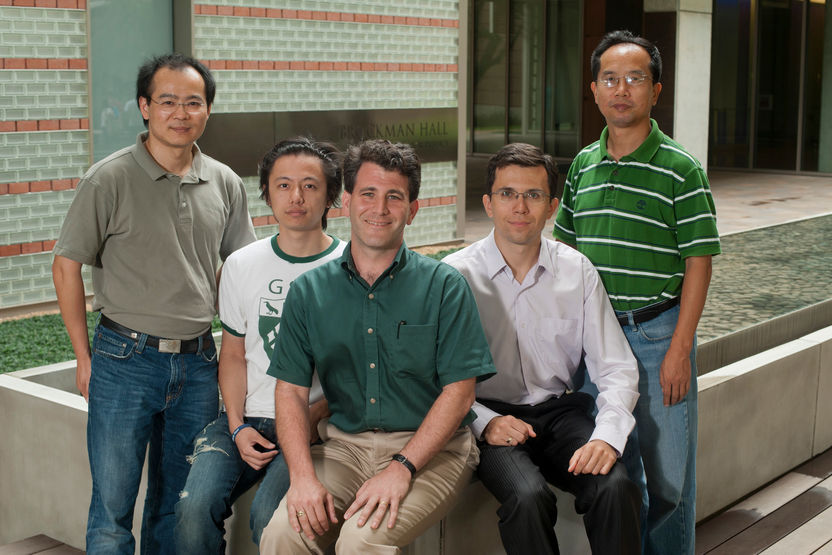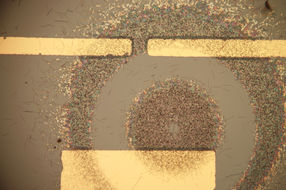Reversible doping: Hydrogen flips switch on vanadium oxide
Rice University physicists find reversible way to alter VO2's unique electronic about-face
If you are not a condensed matter physicist, vanadium oxide (VO2) may be the coolest material you've never heard of. It's a metal. It's an insulator. It's a window coating and an optical switch. And thanks to a new study by physicists at Rice University, scientists have a new way to reversibly alter VO2's electronic properties by treating it with one of the simplest substances -- hydrogen.

Gold electrodes rest on clumps of vanadium oxide (VO2) wires that are each about 1,000 times smaller than a human hair. When baked in the presence of hydrogen gas, the wires next to the electrodes (dark region) absorb hydrogen and exhibit altered electronic behavior.
Jiang Wei/Rice University

Gold electrodes rest on clumps of vanadium oxide (VO2) wires that are each about 1,000 times smaller than a human hair. When baked in the presence of hydrogen gas, the wires next to the electrodes (dark region) absorb hydrogen and exhibit altered electronic behavior.
Jeff Fitlow/Rice University


So what is VO2? It's an oxidized form of the metal vanadium, an ingredient in hardened steel. When oxygen reacts with vanadium to form VO2, the atoms form crystals that look like long rectangular boxes. The vanadium atoms line up along the four edges of the box in regularly spaced rows. A single crystal of VO2 can have many of these boxes lined up side by side, and the crystals conduct electricity like wire as long as they are kept warm.
"The weird thing about this material is that if you cool it, when you get to 67 degrees Celsius, it goes through a phase transition that is both electronic and structural," said Rice's Douglas Natelson, lead co-author of the study in Nature Nanotechnology. "Structurally, the vanadium atoms pair up and each pair is slightly canted, so you no longer have these long chains. When the phase changes, and these pairings take place, the material changes from being a electrical conductor to an electrical insulator."
While other materials exhibit a similar electronic about-face, VO2 is unique in that the change occurs at a relatively modest temperature -- around 153 degrees Fahrenheit -- and sometimes at incredible speed -- less than a trillionth of second. In recent years, scientists have put these quirky properties to work. In 2004, a group in London used VO2 to design a temperature-sensitive window coating that could absorb sunlight on cold days and turn reflective on hot days. And electronics researchers are also working to create optical switches from VO2.
"As an experimental physicist, VO2 is intriguing because the detailed physics of the material are still not well understood, and theoretical models alone cannot give us the answers," said Natelson, professor of physics and astronomy and of electrical and computer engineering at Rice. "Experiments are key to understanding this."
In 2010, Natelson and postdoctoral research associate Jiang Wei began to systematically study the phase changes in VO2. Wei and graduate student Heng Ji began by using a process called vapor deposition to grow VO2 wires that were about 1,000 times smaller than a human hair. One set of experiments on wires that had been baked in the presence of hydrogen gas returned particularly odd readings. Wei, Ji and Natelson determined that the hydrogen was apparently modifying the VO2 nanowires, but only those in contact with metal electrodes.
"The gold electrodes we were using to supply current to the experiment were acting as a catalyst that split the hydrogen gas molecules into atomic hydrogen, which could then diffuse into channels in the VO2," Natelson said. "It appears that the hydrogen is taken up into the VO2 crystals, and this changes their electronic properties. If a little hydrogen is added, the phase transition happens at a slightly lower temperature, and the insulating phase becomes more conductive. If enough hydrogen is added, the transition to the insulating phase disappears altogether."
To gain insight into just how the hydrogen is able to alter the transition, the experimenters consulted with theoretical physicist Andriy Nevidomskyy, assistant professor of physics and astronomy at Rice. Nevidomskyy's calculations showed that the hydrogen changes the amount of charge in the VO2 material and also forces the crystal to expand slightly. Both of these effects favor the metallic state.
This is not the first time physicists have lowered the transition temperature of VO2 by adding other materials -- a technique known as "doping." But Natelson said Rice's hydrogen doping is unique in that it is completely reversible: To remove the hydrogen, the material simply has to be baked in an oven at moderate temperature.
"On the applied side, there may be a number of applications for this, like ultrasensitive hydrogen sensors," Natelson said. "But the more immediate payoff will likely be in helping us to better understand the physics involved in the VO2 phase transition. If we can find out exactly how much hydrogen is required to shut down the transition, then we will have a knob that we can turn to systematically raise or lower the temperature in future experiments."






























































